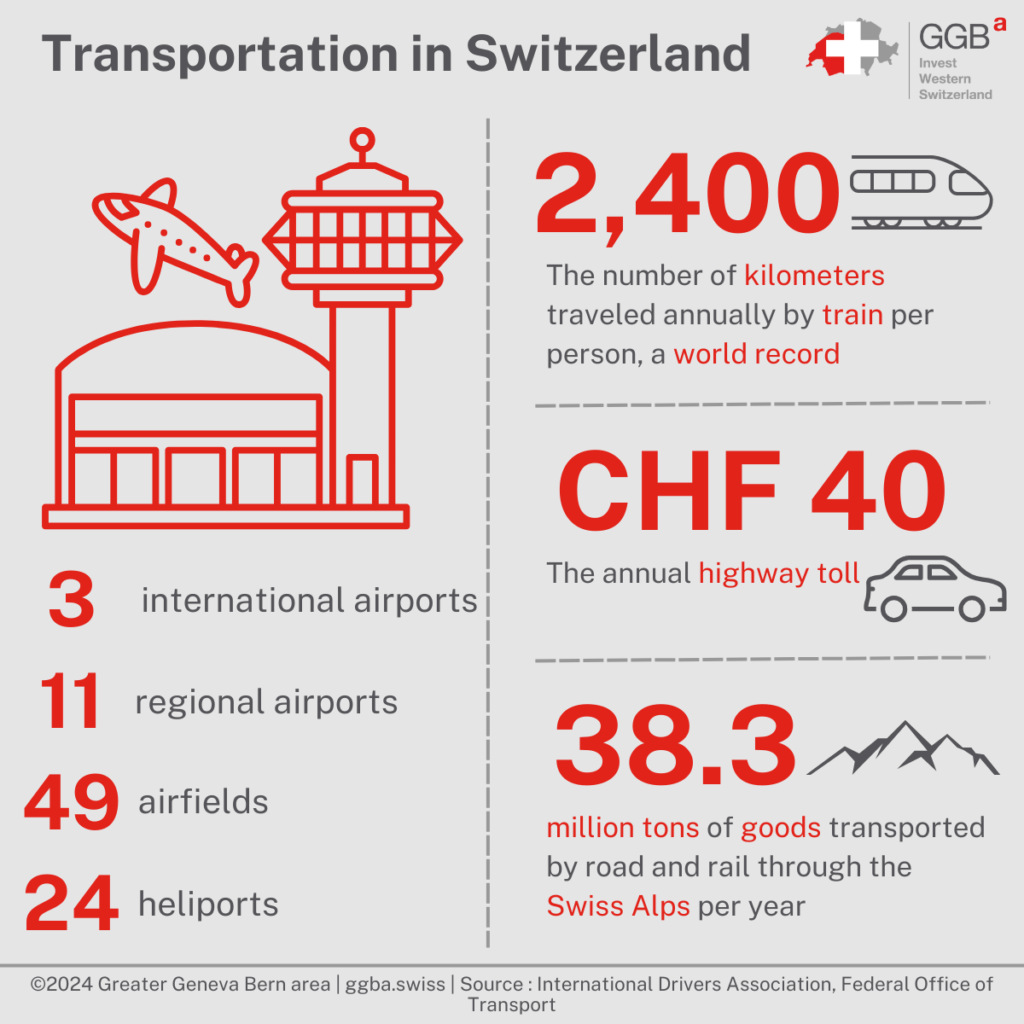
Means of transport in Switzerland

Thanks to its central location in Europe, Switzerland is perfectly integrated into the European transport infrastructure. The area boasts a well-developed infrastructure of roads, railways, and airports, facilitating frequent and secure travel of both individuals and cargo.
The road networks
Switzerland has one of the densest highway networks in the world. According to a study by the International Divers Association, Switzerland has the third highest road quality rating in the world and is considered the most car-friendly country in Europe. Several factors were considered in establishing this ranking, including safety, the quality and extent of the road network, traffic density, and the cost of fuel. In addition, the national roads are major routes for international traffic. For example, the Germany-Italy connection via the Gotthard tunnel is particularly important in Europe.
To use the Swiss road network, all vehicles weighing less than 3.5 tons, whether Swiss or foreign, must have a sticker, the “vignette” valid for one year. Vehicles weighing more than 3.5 tons pay a toll in the form of a heavy vehicle fee. This vignette is required even for an occasional transit. It costs CHF 40.00 and can be purchased at gas stations, highway service areas, customs offices, and post offices. In comparison, the trip from Paris to Nantes (about 385 km on the French road network) will cost about 40 €. Thanks to the annual vignette, it is possible to travel throughout Switzerland for the same price, and this for a whole year. In addition, there are no additional charges for the use of the Gotthard and Great St. Bernard Alpine highway tunnels.
The validity of a foreign driver’s license in Switzerland
If you have a foreign driver’s license and you live in Switzerland, you can drive with this license for twelve months. However, once this period is over, it is imperative that you exchange your foreign license for a Swiss driver’s license.
Failing to do so within a year may lead to a penalty. Please note that the procedures for exchanging your license vary depending on the country of origin of the license:
- For persons with a driving license from an EU or EEA country (Iceland, Lichtenstein, Norway), the Swiss driving license can be obtained without further verification of the person’s driving ability. In addition, the foreign license is returned to the issuing authority.
- If the foreign license is issued by another country, it is necessary to take a driving test and an additional theoretical test for professional drivers to prove one’s ability to drive. Upon completion of these tests, the applicant will be able to obtain a Swiss driver’s license valid for a trial period of three years or without expiration. The document will be sent by mail within a variable period depending on the canton.
Regardless of the situation, it is mandatory to provide the authentic driver’s license and undergo a visual examination. For more information on exchanging a foreign driver’s license for a Swiss one, we recommend that you contact the automobile service of the canton where you live.
For drivers who have a driver’s license issued by a country outside the EU or EFTA, it is recommended to have an international driver’s license when driving in Switzerland for a limited period. This document is often required by countries bordering Switzerland and by car rental services. In Switzerland, the international driving license is only required if the national license does not mention the authorized vehicle categories in Latin characters. The International Driving Permit is valid for three years, but it cannot exceed the expiration date of the national permit. After its expiration, it is possible to order a new one.
The railway networks
Despite the exceptional quality of the Swiss road network, Switzerland is considered a railway country because of the length of its national railroad network, which is three times larger than its highway network. It has one of the densest rail networks in Europe.
Thanks to the punctuality and reliability of public transport, the Swiss are the best rail customers in Europe, according to a study by LITRA (Information Service for Public Transport). Indeed, although the utilization rate is one of the highest in the world, 92.5% of trains arrive on time.
The Swiss Federal Railways (SBB/CFF), which manages most of the Swiss rail network, also offers a wide range of train trips from Switzerland to Europe. You can find more information about train travel from Switzerland to Europe on the official SBB website.
Switzerland is also implementing three major rail projects that offer significant medium- and long-term benefits to the country and Europe. These projects improve transport capacities, relieve the roads of passenger and freight traffic, and contribute to the preservation of the ecologically sensitive Alpine region:
- “ZEB“: adopted by Parliament in 2008, the “Future Development of Rail Infrastructure” project, with a budget of 5.4 billion Swiss francs, includes more than 100 infrastructure projects and should be completed by 2025. It aims to increase the frequency and capacity of rail traffic;
- “AlpTransit/NFLA (New Railway Lines)“: the new Lötschberg and Gotthard railway line through the Alps strengthens Switzerland’s position in Europe by creating new, fast connections between north and south.
- Connection to the European high-speed network: by participating in the European high-speed train network (TGV/ICE), Switzerland has a decisive position in the European high-speed train network. The federal government has invested CHF 1.1 billion in the railway network for this project. Thanks to this project, travel times from Switzerland to Paris, Lyon, Munich, Ulm, and Stuttgart are considerably shorter.
Navigation
Approximately 56% of foreign border workers reside in France. Every day, nearly 2,500 cross-border commuters use the CGN boats to work in Switzerland and cross Lake Geneva. There are three main boat lines connecting the two countries: Lausanne-Evian, Lausanne-Thonon, and Nyon-Yvoire. This maritime link between France and Switzerland is a testament to Switzerland’s strong integration into Europe, promoting cultural and economic exchanges through the mobility of people between the two countries.
Air traffic
In Switzerland, there are three international airports, Geneva, Zurich, and Basel, which offer flights to the main economic and tourist destinations. Due to their geographical proximity to neighboring countries, these airports allow Switzerland to play a crucial role in global trade by facilitating exports and imports with the EU. Air freight is very important for export-oriented companies in these regions: the main export products are chemical and pharmaceutical, high-tech products, automotive parts, and perishable goods. In addition, there are direct flights to some overseas destinations.
The airports of Bern, Lugano, and St.Gallen-Altenrhein offer daily flights to several European destinations. The airports of Sion and St.Moritz-Samedan offer seasonal commercial flights essential for the tourist industry and save time in the entire service sector.
Business flights that can be planned at short notice are becoming increasingly important for internationally active companies. In addition to the national airports, Switzerland has several modern regional airports with infrastructure suitable for business flights. These airports allow customs clearance and the authorized cross-border transport of Schengen citizens. Switzerland has many business flight providers who operate their branches at major airports and airfields.

In a nutshell: Switzerland’s various means of transportation are efficient and punctual, making it easy for travelers to get around and for goods to be transported. The infrastructure is modern and well-maintained, which guarantees safe and reliable travel.
Greater Geneva Bern area (GGBa) is the economic promotion agency for Western Switzerland. If you would like to know more about the different means of transportation in Switzerland or about other subjects that could help you in your implantation, contact us.
Our articles “Why Switzerland” are likely to answer the questions you have.

